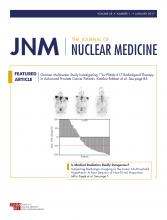Abstract
Cholinergic alterations in dementia with Lewy bodies (DLB) have been widely documented in postmortem studies, whereas in vivo studies are sparse, particularly at the subcortical level. We used 123I-iodobenzovesamicol, a SPECT radiotracer of the vesicular acetylcholine transporter, to evaluate in vivo in DLB the integrity of the 3 main cholinergic pathways—the Ch1 (septohippocampal), the Ch4 (innominatocortical), and the Ch5 (pontothalamic) cholinergic pathways—as well as the striatal cholinergic interneurons. In addition, we assessed the involvement of the cholinergic system in cognitive and neuropsychiatric disorders in DLB patients. Methods: Twelve healthy volunteers (median age, 72 y; interquartile range, 6.25 y) and 11 DLB patients (median age, 76 y; interquartile range, 10.50 y) underwent a dynamic 123I-iodobenzovesamicol SPECT scan and an MRI scan. MR images were automatically segmented, providing the volumes of several regions of interest, including the striatum and cholinergic terminals in Ch1 (hippocampus), Ch4 (cortical lobes), and Ch5 (thalamus). For each region of interest and each subject, pharmacokinetic modeling allowed calculation of the nondisplaceable binding potential (BPND) values for the binding of 123I-iodobenzovesamicol to the vesicular acetylcholine transporter. A neuropsychological evaluation of participants was performed with the Mini-Mental State Examination and the Grober–Buschke, Set, visual discrimination, Benton, and Wechsler tests, and cognitive fluctuations and apathy were also assessed. Results: Compared with BPND values for healthy subjects, BPND values for DLB patients were significantly lower in the Ch4 terminal regions of the anterior cingulate cortex and the superior and inferior parietal cortices (P = 0.0006, 0.0015, and 0.0023, respectively), in the Ch5 terminal region of the thalamus (P = 0.0003), and in the striatum (P = 0.0042). All of the neuropsychological test scores were significantly lower in DLB patients than in healthy subjects. Four DLB patients with apathy and 4 DLB patients without apathy were identified. For the anterior cingulate cortex, compared with BPND values in healthy subjects, BPND values were significantly lower in patients with apathy (P = 0.004) and were unchanged in patients without apathy. Conclusion: Our results confirm the existence in DLB of cholinergic alterations, reaching both cortical and subcortical levels, including the Ch5 pathway and the striatum. Alterations in cholinergic transmission in the anterior cingulate cortex could be closely associated with the development of apathy.
Footnotes
Published online Jul. 28, 2016.
- © 2017 by the Society of Nuclear Medicine and Molecular Imaging.







